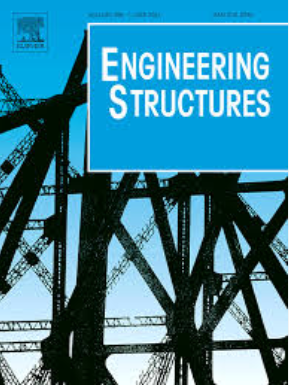Seismic resilience assessment method for railway simply supported bridges based on girder-track model
IF 6.4
1区 工程技术
Q1 ENGINEERING, CIVIL
引用次数: 0
Abstract
Currently, the evaluation of the seismic resilience of bridges is a research hotspot. The empirical quantitative relationship between structural damage and traffic functionality loss has unclear mechanical significance. Traditional functionality recovery functions face difficulty in considering the contribution and repair order of components. This study used the vehicle speed as a quantitative indicator of traffic functionality. The girder track model (GTM) analysis method is proposed, and track irregularity (TI) is used as a track damage indicator, serving as the link between structural damage and traffic functionality loss. Moreover, the traffic functionality loss can be calculated based on speed loss, and two types of functionality recovery curves are proposed with consideration to the order of component repair and the variable weight coefficient. Three seismic resilience levels are proposed, namely, normal speed passage, speed-restricted passage, and closed passage. A method for evaluating the seismic resilience of railway bridges has been established. A five-span simply supported girder bridge was subjected to nonlinear analysis to validate the feasibility of the proposed method. The results reveal that the damages of bearings and piers have priority over track damage, but the damage evolution speed of the track structures is the fastest. The component weight coefficients of functionality recovery changed significantly as the seismic intensity increased. The recommended evaluation thresholds for the three seismic resilience levels of traffic functionality are 0.81 and 0.40.
基于梁-轨道模型的铁路简支桥抗震回弹评估方法
目前,桥梁抗震弹性评价是一个研究热点。结构损伤与交通功能损失之间的经验定量关系没有明确的力学意义。传统的功能恢复函数难以考虑部件的贡献和修复顺序。本研究使用车速作为交通功能的定量指标。提出了钢梁轨道模型(GTM)分析方法,将轨道不平顺度(TI)作为轨道损伤指标,作为连接结构损伤与交通功能损失的纽带。基于速度损失计算交通功能损失,提出了考虑部件修复顺序和变权系数的两种功能恢复曲线。提出了正常速度通道、限速通道和封闭通道三个抗震回弹等级。建立了铁路桥梁抗震性能的评价方法。通过对一座五跨简支梁桥的非线性分析,验证了该方法的可行性。结果表明:支座和桥墩损伤优先于轨道损伤,但轨道结构损伤演化速度最快;随着地震烈度的增加,功能恢复分量权重系数变化显著。建议的三个交通功能抗震恢复等级的评价阈值分别为0.81和0.40。
本文章由计算机程序翻译,如有差异,请以英文原文为准。
求助全文
约1分钟内获得全文
求助全文
来源期刊

Engineering Structures
工程技术-工程:土木
CiteScore
10.20
自引率
14.50%
发文量
1385
审稿时长
67 days
期刊介绍:
Engineering Structures provides a forum for a broad blend of scientific and technical papers to reflect the evolving needs of the structural engineering and structural mechanics communities. Particularly welcome are contributions dealing with applications of structural engineering and mechanics principles in all areas of technology. The journal aspires to a broad and integrated coverage of the effects of dynamic loadings and of the modelling techniques whereby the structural response to these loadings may be computed.
The scope of Engineering Structures encompasses, but is not restricted to, the following areas: infrastructure engineering; earthquake engineering; structure-fluid-soil interaction; wind engineering; fire engineering; blast engineering; structural reliability/stability; life assessment/integrity; structural health monitoring; multi-hazard engineering; structural dynamics; optimization; expert systems; experimental modelling; performance-based design; multiscale analysis; value engineering.
Topics of interest include: tall buildings; innovative structures; environmentally responsive structures; bridges; stadiums; commercial and public buildings; transmission towers; television and telecommunication masts; foldable structures; cooling towers; plates and shells; suspension structures; protective structures; smart structures; nuclear reactors; dams; pressure vessels; pipelines; tunnels.
Engineering Structures also publishes review articles, short communications and discussions, book reviews, and a diary on international events related to any aspect of structural engineering.
 求助内容:
求助内容: 应助结果提醒方式:
应助结果提醒方式:


